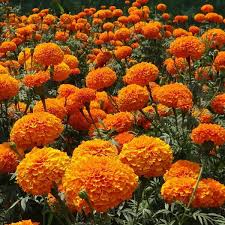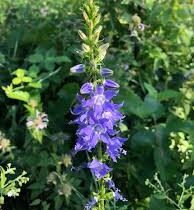Marigolds, belonging to the genus Tagetes, are vibrant annual flowering plants native to the Americas. Known for their striking colors and easy care, marigolds are a favorite among gardeners. This guide provides detailed information about marigolds, including their benefits, types, planting, care, and management.
Definition and Benefits of Marigolds
Marigolds are recognized for their vibrant blooms, which range from deep orange to bright yellow. Beyond their aesthetic appeal, they offer several practical benefits:
- Pest Deterrence: Marigolds repel pests like aphids, nematodes, and whiteflies, making them excellent companions for vegetable gardens.
- Soil Improvement: Their roots can help suppress certain soil-borne diseases and improve overall soil health.
- Pollinator Attraction: Marigolds attract beneficial insects, including bees and butterflies, which promote a healthy ecosystem.
- Aesthetic Appeal: Their cheerful colors and varied sizes make marigolds a versatile choice for any garden design.
Basics of Marigolds
- Common Name: Marigold
- Botanical Name: Tagetes spp.
- Family: Asteraceae
- Plant Type: Herbaceous, annual
- Mature Size: 4–48 inches tall, 6–24 inches wide
- Sun Exposure: Full sun
- Soil Type: Evenly moist, well-drained
- Soil pH: Slightly acidic to neutral (6.0 to 7.0)
- Bloom Time: Summer
- Flower Colors: Yellow, orange, white, red, gold, bicolor
- Hardiness Zones: 2-11 (USDA); annual in all zones
- Native Area: Southern North America (Mexico)
Choosing Which Marigolds to Grow
Marigolds are versatile and come in various types, each with unique characteristics. Here are the primary types:
- Tagetes erecta (African Marigold)
- Description: Large, globe-shaped blooms (up to 5 inches in diameter) in rich yellow or orange with dark green, aromatic, deeply lobed leaves.
- Height: 12 to 36 inches tall.
- Bloom Time: Late spring until frost.
- Ideal Uses: Bold statements in flower beds or borders; great for mass plantings and cut flowers.
- Special Notes: Prefers full sun and well-draining soil; effective in repelling pests.
- Tagetes patula (French Marigold)
- Description: Smaller, compact blooms in shades of yellow, orange, and red with fern-like dark green leaves.
- Height: 6 to 18 inches tall.
- Bloom Time: Continuous blooms from early summer until frost.
- Ideal Uses: Borders, edging, and containers; effective in companion planting for pest deterrence.
- Special Notes: Thrives in full sun and is adaptable to various soil types.
- Tagetes tenuifolia (Signet Marigold)
- Description: Small, daisy-like blooms with bright yellow or orange colors; delicate, feathery leaves with a pleasant scent.
- Height: 12 to 18 inches tall.
- Bloom Time: Early summer through fall.
- Ideal Uses: Containers, hanging baskets, and ground cover; edible flowers for salads and garnishes.
- Special Notes: Drought-tolerant once established; attracts beneficial insects.
- Tagetes lucida (Mexican Marigold)
- Description: Bright yellow, cup-shaped blooms; aromatic dark green leaves often used in cooking.
- Height: 18 to 24 inches tall.
- Bloom Time: Late summer until the first frost.
- Ideal Uses: Culinary and medicinal applications; also ornamental.
- Special Notes: Prefers well-draining soil and full sun; has a long history in traditional medicine.
When to Plant Marigold Seeds
Getting the Planting Site Ready
Select a sunny location with well-draining soil. Marigolds thrive in slightly acidic to neutral pH levels. Prepare the soil by loosening it and incorporating organic matter, such as compost, to enhance fertility.
Timing for Planting
- Indoors: Start seeds 6-8 weeks before the last frost date for a head start in the growing season.
- Outdoors: Transplant outdoors after the danger of frost has passed. In warmer regions, direct sow seeds in late winter or early spring.
Specific Timing for Arizona
In Arizona, sow marigold seeds directly in the garden from late February to early March for spring blooms or in September for vibrant fall displays.
Should You Start Marigold Seeds Indoors?
Starting seeds indoors is highly recommended, especially in cooler climates. Use seed trays and provide ample light to encourage healthy growth before transplanting.
Growing Marigolds
Planting Location
Choose a location that receives at least 6 hours of direct sunlight daily. Marigolds thrive in well-draining soil with a slightly acidic to neutral pH.
Spacing
Space marigolds about 8 to 12 inches apart, depending on the variety, to allow for proper air circulation and prevent overcrowding.
Care and Maintenance
Watering
Marigolds prefer moderate watering. Ensure the soil remains moist but not soggy. Water deeply but infrequently, allowing the top inch of soil to dry out between waterings.
Fertilization
While marigolds are not heavy feeders, apply a balanced, slow-release fertilizer at planting time to promote healthy growth. Avoid over-fertilizing to prevent excessive foliage with fewer blooms.
Pruning and Deadheading
Regular deadheading—removing spent flowers—encourages new blooms and extends the flowering season. Trim back leggy growth to maintain a bushy shape.
Pest and Disease Management
Marigold Pests and Diseases
Marigolds are relatively pest-resistant, but monitor for aphids and spider mites. Use insecticidal soap or neem oil to treat infestations. Ensure good air circulation to prevent fungal diseases.
Identifying and Treating Diseases
Common problems include powdery mildew and root rot. Ensure good air circulation around the plants and avoid overwatering. Treatments may involve fungicides or removing infected plants.
Identifying and Fixing Signs of Distress
Watch for yellowing leaves or stunted growth, which may indicate nutrient deficiencies or pest infestations. Address these issues promptly by adjusting your care routine or using organic pest control methods.
Planting Marigolds in the Garden
How to Use Marigolds
Marigolds can be planted in borders, as fillers in flower beds, or in containers. Their bright colors complement other plants and create a stunning visual display throughout the growing season.
Companion Planting
Plant marigolds alongside vegetables like tomatoes and peppers to maximize pest deterrence and improve soil health. Their ability to repel harmful insects makes them valuable allies in the garden.
End of Season Care for Marigolds
As the growing season comes to an end, properly care for your marigolds. Cut back the plants to promote healthy growth for the next year, and consider collecting seeds for future planting.
Winter Care
In cooler climates, marigolds will die back with frost. You can remove spent plants and add them to the compost pile, enriching your soil for the next planting season. In warmer regions, marigolds may reseed themselves, providing a vibrant display the following year.
Seed Collection
To collect seeds, allow some marigold flowers to fully mature and dry on the plant. Once dried, harvest the seeds and store them in a cool, dry place for future planting.
With their cheerful blooms and numerous benefits, marigolds are an excellent choice for any garden, ensuring beauty and ecological health throughout the growing season.








Leave a Reply
View Comments